Trade Me Group: ABC Implementation in Managerial Accounting
VerifiedAdded on 2023/06/12
|10
|2766
|327
Report
AI Summary
This report provides an in-depth analysis of activity-based costing (ABC) within the Trade Me Group, an ASX-listed company. It begins by outlining the key features of ABC and its application in the organization, highlighting how it addresses the shortcomings of traditional costing methods by accurately allocating indirect costs. The report discusses how ABC can enhance the top management structure and align with the firm's current objectives, including cost reduction and process simplification. Recommendations for implementing ABC models are provided, emphasizing the importance of prioritizing exploration projects and leveraging information technology. Additionally, the report explores other management accounting tools, such as absorption and marginal costing, that can complement ABC to improve cost control and profitability. The overall aim is to demonstrate how ABC can help Trade Me Group achieve better cost management and strategic decision-making.
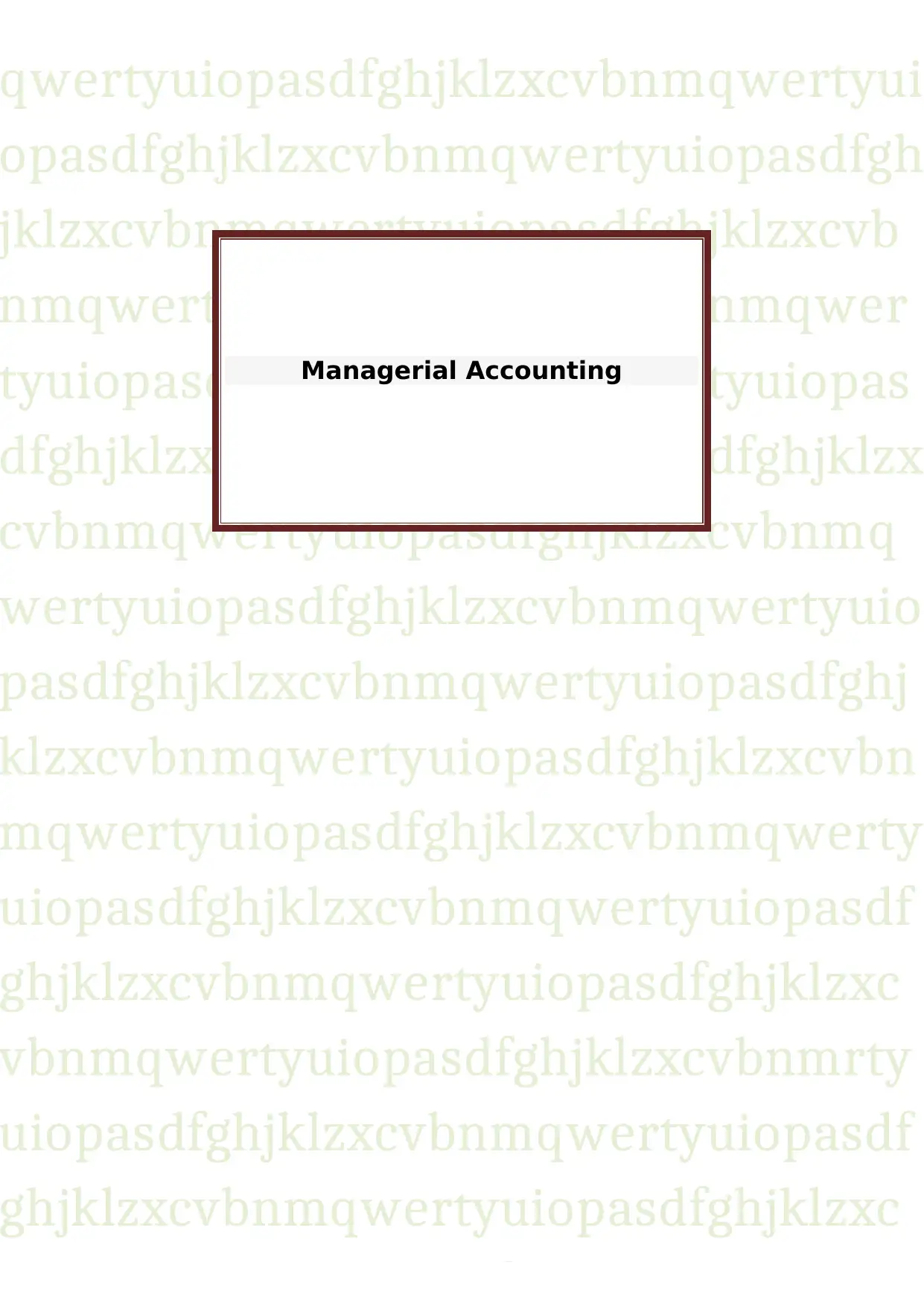
qwertyuiopasdfghjklzxcvbnmqwertyui
opasdfghjklzxcvbnmqwertyuiopasdfgh
jklzxcvbnmqwertyuiopasdfghjklzxcvb
nmqwertyuiopasdfghjklzxcvbnmqwer
tyuiopasdfghjklzxcvbnmqwertyuiopas
dfghjklzxcvbnmqwertyuiopasdfghjklzx
cvbnmqwertyuiopasdfghjklzxcvbnmq
wertyuiopasdfghjklzxcvbnmqwertyuio
pasdfghjklzxcvbnmqwertyuiopasdfghj
klzxcvbnmqwertyuiopasdfghjklzxcvbn
mqwertyuiopasdfghjklzxcvbnmqwerty
uiopasdfghjklzxcvbnmqwertyuiopasdf
ghjklzxcvbnmqwertyuiopasdfghjklzxc
vbnmqwertyuiopasdfghjklzxcvbnmrty
uiopasdfghjklzxcvbnmqwertyuiopasdf
ghjklzxcvbnmqwertyuiopasdfghjklzxc
vbnmqwertyuiopasdfghjklzxcvbnmqw
Managerial Accounting
opasdfghjklzxcvbnmqwertyuiopasdfgh
jklzxcvbnmqwertyuiopasdfghjklzxcvb
nmqwertyuiopasdfghjklzxcvbnmqwer
tyuiopasdfghjklzxcvbnmqwertyuiopas
dfghjklzxcvbnmqwertyuiopasdfghjklzx
cvbnmqwertyuiopasdfghjklzxcvbnmq
wertyuiopasdfghjklzxcvbnmqwertyuio
pasdfghjklzxcvbnmqwertyuiopasdfghj
klzxcvbnmqwertyuiopasdfghjklzxcvbn
mqwertyuiopasdfghjklzxcvbnmqwerty
uiopasdfghjklzxcvbnmqwertyuiopasdf
ghjklzxcvbnmqwertyuiopasdfghjklzxc
vbnmqwertyuiopasdfghjklzxcvbnmrty
uiopasdfghjklzxcvbnmqwertyuiopasdf
ghjklzxcvbnmqwertyuiopasdfghjklzxc
vbnmqwertyuiopasdfghjklzxcvbnmqw
Managerial Accounting
Paraphrase This Document
Need a fresh take? Get an instant paraphrase of this document with our AI Paraphraser
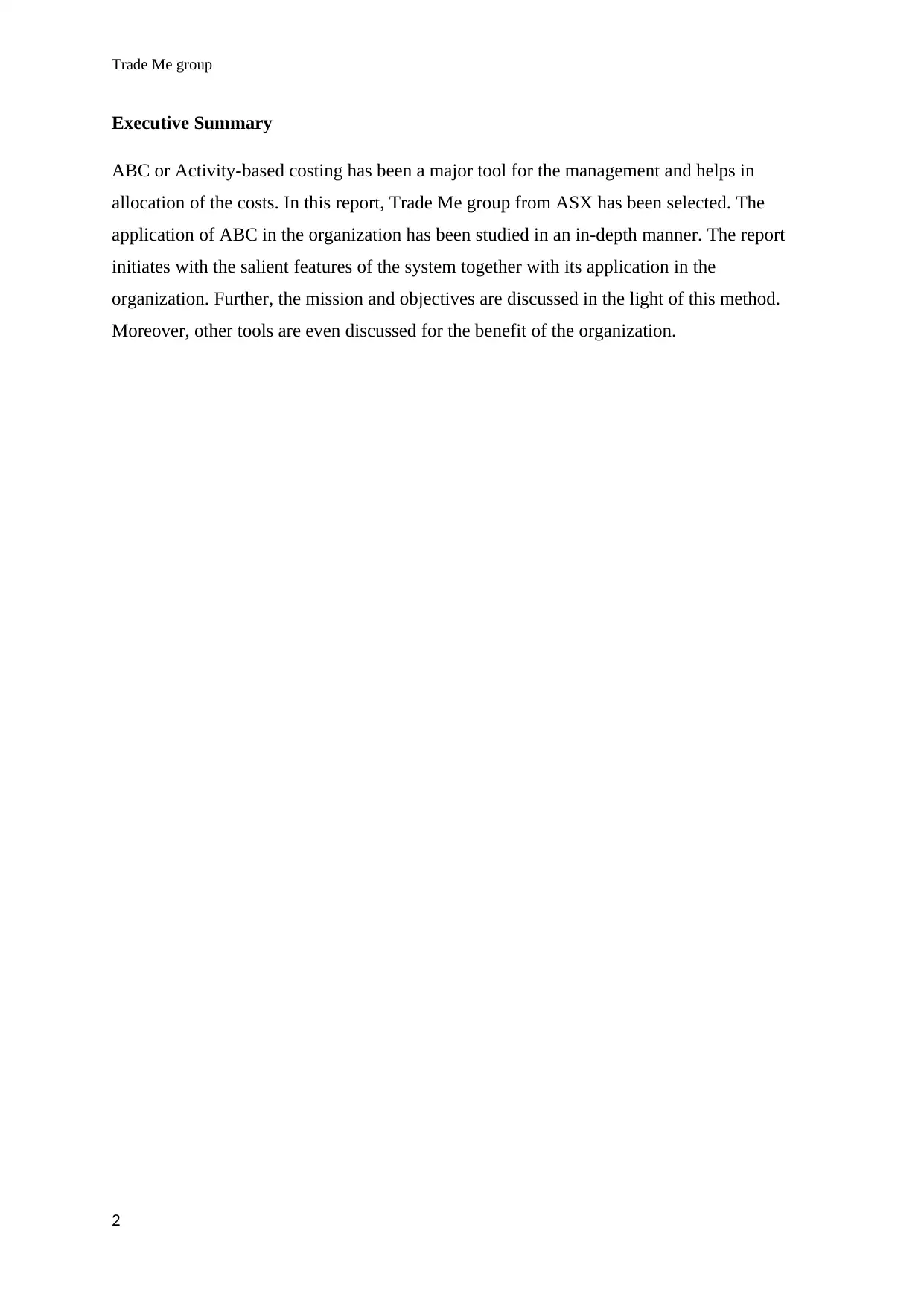
Trade Me group
Executive Summary
ABC or Activity-based costing has been a major tool for the management and helps in
allocation of the costs. In this report, Trade Me group from ASX has been selected. The
application of ABC in the organization has been studied in an in-depth manner. The report
initiates with the salient features of the system together with its application in the
organization. Further, the mission and objectives are discussed in the light of this method.
Moreover, other tools are even discussed for the benefit of the organization.
2
Executive Summary
ABC or Activity-based costing has been a major tool for the management and helps in
allocation of the costs. In this report, Trade Me group from ASX has been selected. The
application of ABC in the organization has been studied in an in-depth manner. The report
initiates with the salient features of the system together with its application in the
organization. Further, the mission and objectives are discussed in the light of this method.
Moreover, other tools are even discussed for the benefit of the organization.
2
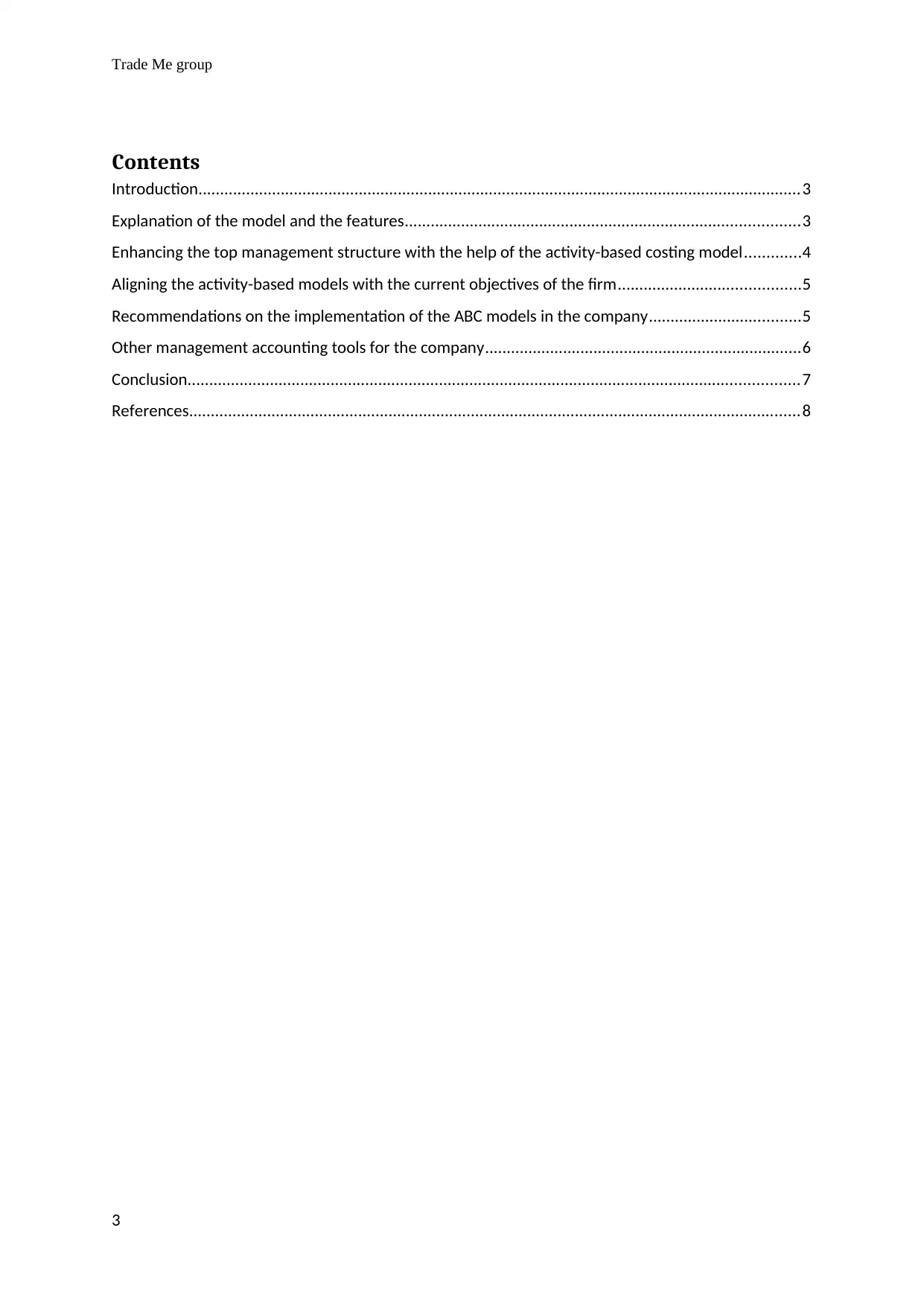
Trade Me group
Contents
Introduction...........................................................................................................................................3
Explanation of the model and the features...........................................................................................3
Enhancing the top management structure with the help of the activity-based costing model.............4
Aligning the activity-based models with the current objectives of the firm..........................................5
Recommendations on the implementation of the ABC models in the company...................................5
Other management accounting tools for the company.........................................................................6
Conclusion.............................................................................................................................................7
References.............................................................................................................................................8
3
Contents
Introduction...........................................................................................................................................3
Explanation of the model and the features...........................................................................................3
Enhancing the top management structure with the help of the activity-based costing model.............4
Aligning the activity-based models with the current objectives of the firm..........................................5
Recommendations on the implementation of the ABC models in the company...................................5
Other management accounting tools for the company.........................................................................6
Conclusion.............................................................................................................................................7
References.............................................................................................................................................8
3
⊘ This is a preview!⊘
Do you want full access?
Subscribe today to unlock all pages.

Trusted by 1+ million students worldwide
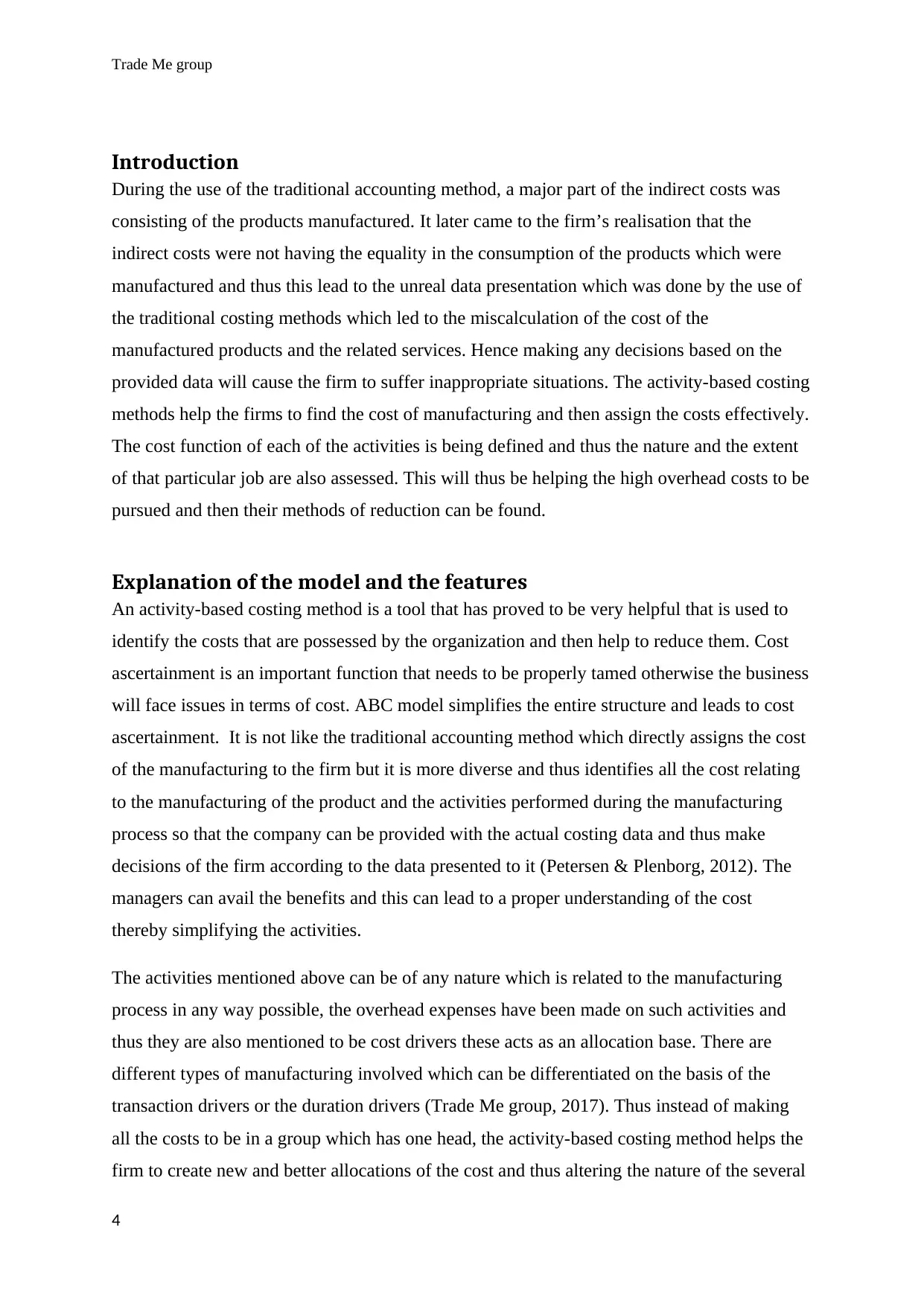
Trade Me group
Introduction
During the use of the traditional accounting method, a major part of the indirect costs was
consisting of the products manufactured. It later came to the firm’s realisation that the
indirect costs were not having the equality in the consumption of the products which were
manufactured and thus this lead to the unreal data presentation which was done by the use of
the traditional costing methods which led to the miscalculation of the cost of the
manufactured products and the related services. Hence making any decisions based on the
provided data will cause the firm to suffer inappropriate situations. The activity-based costing
methods help the firms to find the cost of manufacturing and then assign the costs effectively.
The cost function of each of the activities is being defined and thus the nature and the extent
of that particular job are also assessed. This will thus be helping the high overhead costs to be
pursued and then their methods of reduction can be found.
Explanation of the model and the features
An activity-based costing method is a tool that has proved to be very helpful that is used to
identify the costs that are possessed by the organization and then help to reduce them. Cost
ascertainment is an important function that needs to be properly tamed otherwise the business
will face issues in terms of cost. ABC model simplifies the entire structure and leads to cost
ascertainment. It is not like the traditional accounting method which directly assigns the cost
of the manufacturing to the firm but it is more diverse and thus identifies all the cost relating
to the manufacturing of the product and the activities performed during the manufacturing
process so that the company can be provided with the actual costing data and thus make
decisions of the firm according to the data presented to it (Petersen & Plenborg, 2012). The
managers can avail the benefits and this can lead to a proper understanding of the cost
thereby simplifying the activities.
The activities mentioned above can be of any nature which is related to the manufacturing
process in any way possible, the overhead expenses have been made on such activities and
thus they are also mentioned to be cost drivers these acts as an allocation base. There are
different types of manufacturing involved which can be differentiated on the basis of the
transaction drivers or the duration drivers (Trade Me group, 2017). Thus instead of making
all the costs to be in a group which has one head, the activity-based costing method helps the
firm to create new and better allocations of the cost and thus altering the nature of the several
4
Introduction
During the use of the traditional accounting method, a major part of the indirect costs was
consisting of the products manufactured. It later came to the firm’s realisation that the
indirect costs were not having the equality in the consumption of the products which were
manufactured and thus this lead to the unreal data presentation which was done by the use of
the traditional costing methods which led to the miscalculation of the cost of the
manufactured products and the related services. Hence making any decisions based on the
provided data will cause the firm to suffer inappropriate situations. The activity-based costing
methods help the firms to find the cost of manufacturing and then assign the costs effectively.
The cost function of each of the activities is being defined and thus the nature and the extent
of that particular job are also assessed. This will thus be helping the high overhead costs to be
pursued and then their methods of reduction can be found.
Explanation of the model and the features
An activity-based costing method is a tool that has proved to be very helpful that is used to
identify the costs that are possessed by the organization and then help to reduce them. Cost
ascertainment is an important function that needs to be properly tamed otherwise the business
will face issues in terms of cost. ABC model simplifies the entire structure and leads to cost
ascertainment. It is not like the traditional accounting method which directly assigns the cost
of the manufacturing to the firm but it is more diverse and thus identifies all the cost relating
to the manufacturing of the product and the activities performed during the manufacturing
process so that the company can be provided with the actual costing data and thus make
decisions of the firm according to the data presented to it (Petersen & Plenborg, 2012). The
managers can avail the benefits and this can lead to a proper understanding of the cost
thereby simplifying the activities.
The activities mentioned above can be of any nature which is related to the manufacturing
process in any way possible, the overhead expenses have been made on such activities and
thus they are also mentioned to be cost drivers these acts as an allocation base. There are
different types of manufacturing involved which can be differentiated on the basis of the
transaction drivers or the duration drivers (Trade Me group, 2017). Thus instead of making
all the costs to be in a group which has one head, the activity-based costing method helps the
firm to create new and better allocations of the cost and thus altering the nature of the several
4
Paraphrase This Document
Need a fresh take? Get an instant paraphrase of this document with our AI Paraphraser
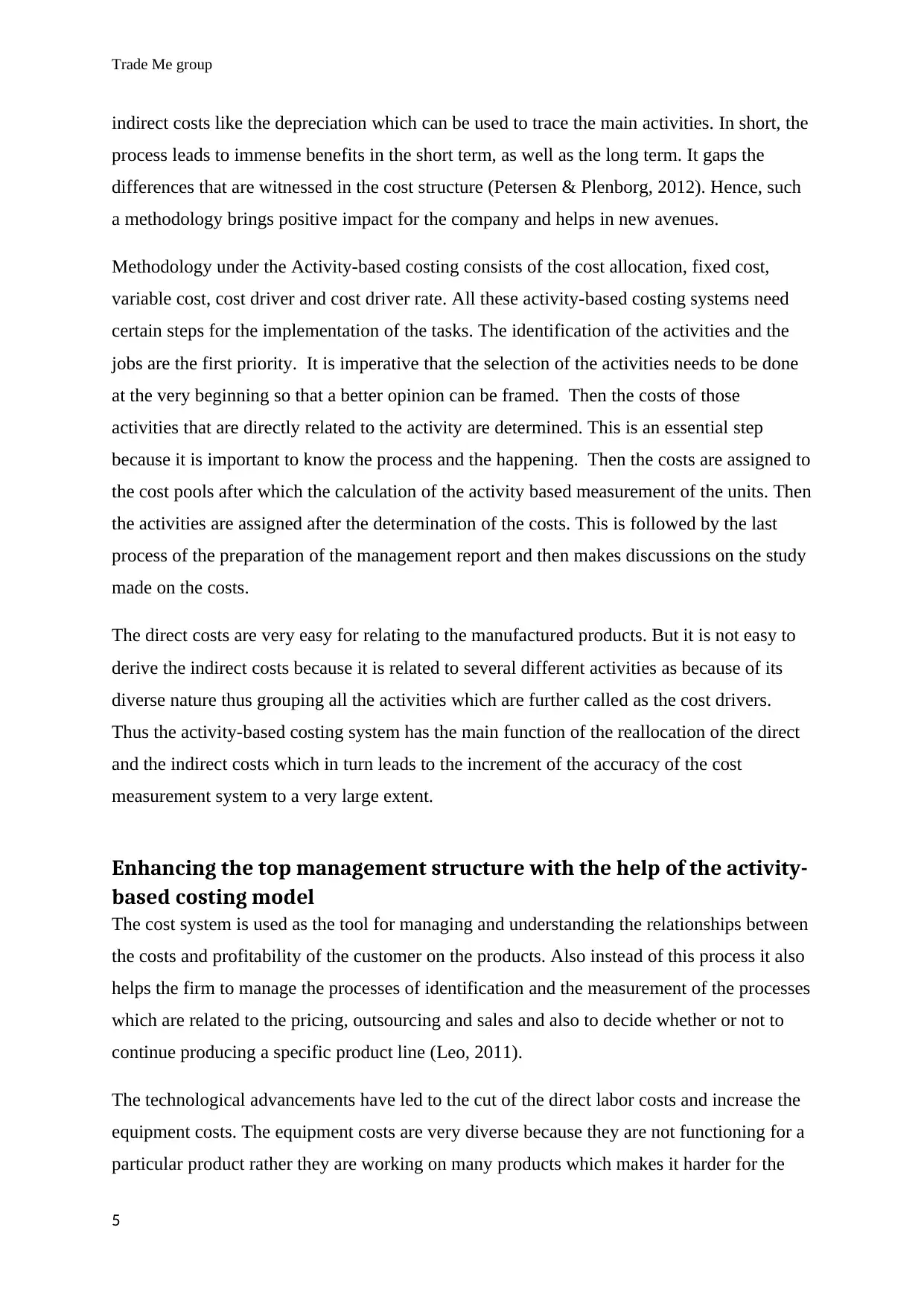
Trade Me group
indirect costs like the depreciation which can be used to trace the main activities. In short, the
process leads to immense benefits in the short term, as well as the long term. It gaps the
differences that are witnessed in the cost structure (Petersen & Plenborg, 2012). Hence, such
a methodology brings positive impact for the company and helps in new avenues.
Methodology under the Activity-based costing consists of the cost allocation, fixed cost,
variable cost, cost driver and cost driver rate. All these activity-based costing systems need
certain steps for the implementation of the tasks. The identification of the activities and the
jobs are the first priority. It is imperative that the selection of the activities needs to be done
at the very beginning so that a better opinion can be framed. Then the costs of those
activities that are directly related to the activity are determined. This is an essential step
because it is important to know the process and the happening. Then the costs are assigned to
the cost pools after which the calculation of the activity based measurement of the units. Then
the activities are assigned after the determination of the costs. This is followed by the last
process of the preparation of the management report and then makes discussions on the study
made on the costs.
The direct costs are very easy for relating to the manufactured products. But it is not easy to
derive the indirect costs because it is related to several different activities as because of its
diverse nature thus grouping all the activities which are further called as the cost drivers.
Thus the activity-based costing system has the main function of the reallocation of the direct
and the indirect costs which in turn leads to the increment of the accuracy of the cost
measurement system to a very large extent.
Enhancing the top management structure with the help of the activity-
based costing model
The cost system is used as the tool for managing and understanding the relationships between
the costs and profitability of the customer on the products. Also instead of this process it also
helps the firm to manage the processes of identification and the measurement of the processes
which are related to the pricing, outsourcing and sales and also to decide whether or not to
continue producing a specific product line (Leo, 2011).
The technological advancements have led to the cut of the direct labor costs and increase the
equipment costs. The equipment costs are very diverse because they are not functioning for a
particular product rather they are working on many products which makes it harder for the
5
indirect costs like the depreciation which can be used to trace the main activities. In short, the
process leads to immense benefits in the short term, as well as the long term. It gaps the
differences that are witnessed in the cost structure (Petersen & Plenborg, 2012). Hence, such
a methodology brings positive impact for the company and helps in new avenues.
Methodology under the Activity-based costing consists of the cost allocation, fixed cost,
variable cost, cost driver and cost driver rate. All these activity-based costing systems need
certain steps for the implementation of the tasks. The identification of the activities and the
jobs are the first priority. It is imperative that the selection of the activities needs to be done
at the very beginning so that a better opinion can be framed. Then the costs of those
activities that are directly related to the activity are determined. This is an essential step
because it is important to know the process and the happening. Then the costs are assigned to
the cost pools after which the calculation of the activity based measurement of the units. Then
the activities are assigned after the determination of the costs. This is followed by the last
process of the preparation of the management report and then makes discussions on the study
made on the costs.
The direct costs are very easy for relating to the manufactured products. But it is not easy to
derive the indirect costs because it is related to several different activities as because of its
diverse nature thus grouping all the activities which are further called as the cost drivers.
Thus the activity-based costing system has the main function of the reallocation of the direct
and the indirect costs which in turn leads to the increment of the accuracy of the cost
measurement system to a very large extent.
Enhancing the top management structure with the help of the activity-
based costing model
The cost system is used as the tool for managing and understanding the relationships between
the costs and profitability of the customer on the products. Also instead of this process it also
helps the firm to manage the processes of identification and the measurement of the processes
which are related to the pricing, outsourcing and sales and also to decide whether or not to
continue producing a specific product line (Leo, 2011).
The technological advancements have led to the cut of the direct labor costs and increase the
equipment costs. The equipment costs are very diverse because they are not functioning for a
particular product rather they are working on many products which makes it harder for the
5
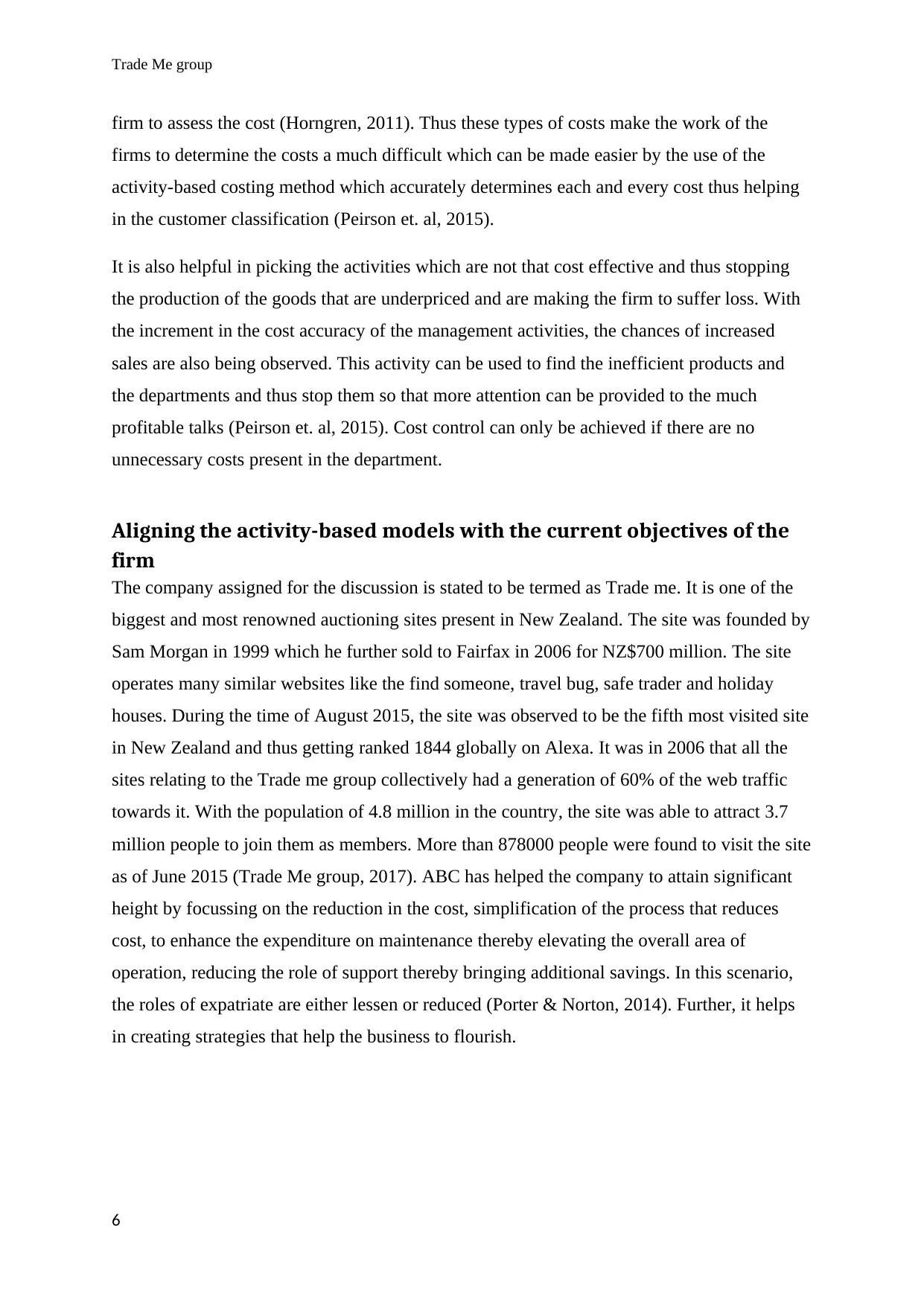
Trade Me group
firm to assess the cost (Horngren, 2011). Thus these types of costs make the work of the
firms to determine the costs a much difficult which can be made easier by the use of the
activity-based costing method which accurately determines each and every cost thus helping
in the customer classification (Peirson et. al, 2015).
It is also helpful in picking the activities which are not that cost effective and thus stopping
the production of the goods that are underpriced and are making the firm to suffer loss. With
the increment in the cost accuracy of the management activities, the chances of increased
sales are also being observed. This activity can be used to find the inefficient products and
the departments and thus stop them so that more attention can be provided to the much
profitable talks (Peirson et. al, 2015). Cost control can only be achieved if there are no
unnecessary costs present in the department.
Aligning the activity-based models with the current objectives of the
firm
The company assigned for the discussion is stated to be termed as Trade me. It is one of the
biggest and most renowned auctioning sites present in New Zealand. The site was founded by
Sam Morgan in 1999 which he further sold to Fairfax in 2006 for NZ$700 million. The site
operates many similar websites like the find someone, travel bug, safe trader and holiday
houses. During the time of August 2015, the site was observed to be the fifth most visited site
in New Zealand and thus getting ranked 1844 globally on Alexa. It was in 2006 that all the
sites relating to the Trade me group collectively had a generation of 60% of the web traffic
towards it. With the population of 4.8 million in the country, the site was able to attract 3.7
million people to join them as members. More than 878000 people were found to visit the site
as of June 2015 (Trade Me group, 2017). ABC has helped the company to attain significant
height by focussing on the reduction in the cost, simplification of the process that reduces
cost, to enhance the expenditure on maintenance thereby elevating the overall area of
operation, reducing the role of support thereby bringing additional savings. In this scenario,
the roles of expatriate are either lessen or reduced (Porter & Norton, 2014). Further, it helps
in creating strategies that help the business to flourish.
6
firm to assess the cost (Horngren, 2011). Thus these types of costs make the work of the
firms to determine the costs a much difficult which can be made easier by the use of the
activity-based costing method which accurately determines each and every cost thus helping
in the customer classification (Peirson et. al, 2015).
It is also helpful in picking the activities which are not that cost effective and thus stopping
the production of the goods that are underpriced and are making the firm to suffer loss. With
the increment in the cost accuracy of the management activities, the chances of increased
sales are also being observed. This activity can be used to find the inefficient products and
the departments and thus stop them so that more attention can be provided to the much
profitable talks (Peirson et. al, 2015). Cost control can only be achieved if there are no
unnecessary costs present in the department.
Aligning the activity-based models with the current objectives of the
firm
The company assigned for the discussion is stated to be termed as Trade me. It is one of the
biggest and most renowned auctioning sites present in New Zealand. The site was founded by
Sam Morgan in 1999 which he further sold to Fairfax in 2006 for NZ$700 million. The site
operates many similar websites like the find someone, travel bug, safe trader and holiday
houses. During the time of August 2015, the site was observed to be the fifth most visited site
in New Zealand and thus getting ranked 1844 globally on Alexa. It was in 2006 that all the
sites relating to the Trade me group collectively had a generation of 60% of the web traffic
towards it. With the population of 4.8 million in the country, the site was able to attract 3.7
million people to join them as members. More than 878000 people were found to visit the site
as of June 2015 (Trade Me group, 2017). ABC has helped the company to attain significant
height by focussing on the reduction in the cost, simplification of the process that reduces
cost, to enhance the expenditure on maintenance thereby elevating the overall area of
operation, reducing the role of support thereby bringing additional savings. In this scenario,
the roles of expatriate are either lessen or reduced (Porter & Norton, 2014). Further, it helps
in creating strategies that help the business to flourish.
6
⊘ This is a preview!⊘
Do you want full access?
Subscribe today to unlock all pages.

Trusted by 1+ million students worldwide
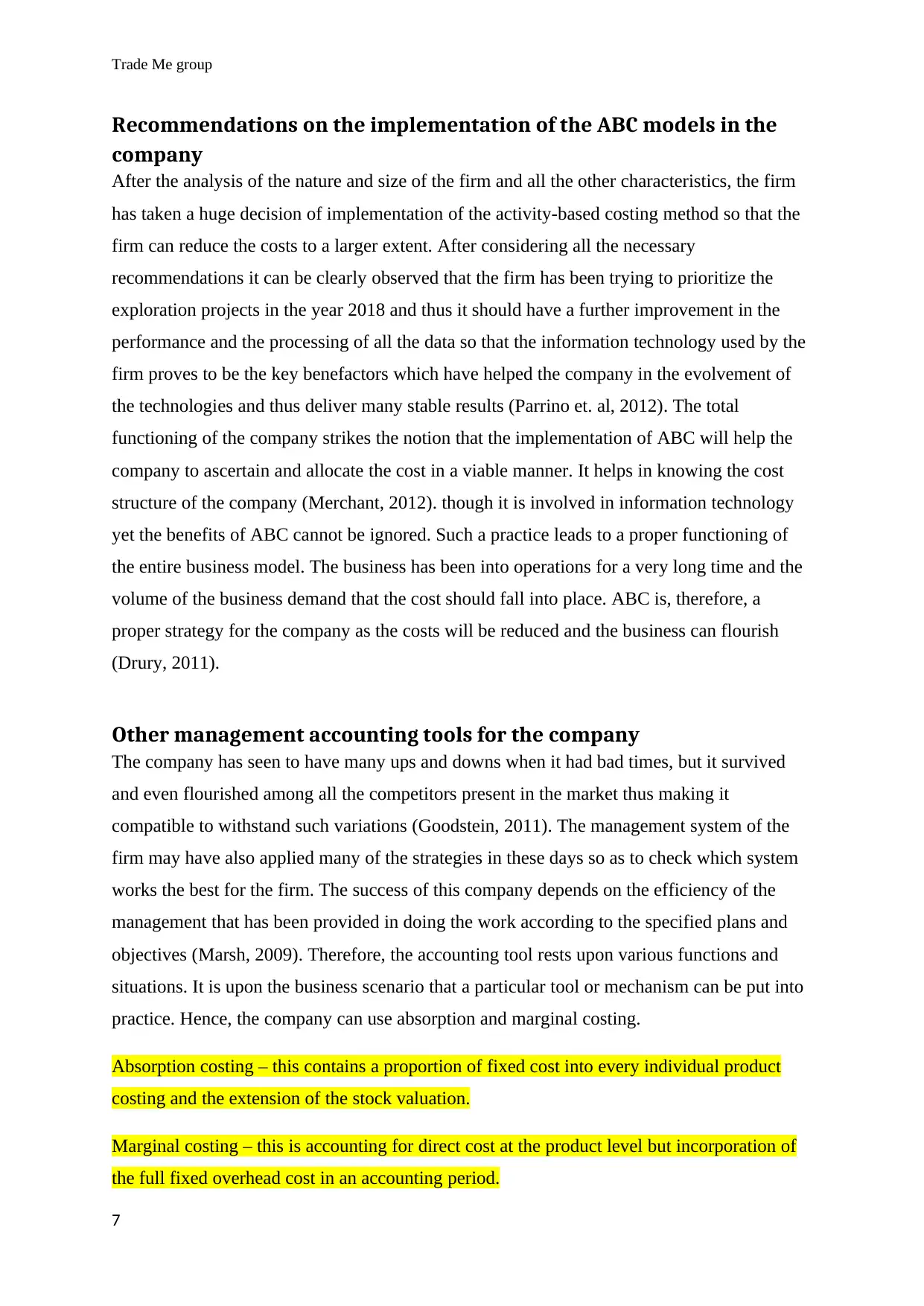
Trade Me group
Recommendations on the implementation of the ABC models in the
company
After the analysis of the nature and size of the firm and all the other characteristics, the firm
has taken a huge decision of implementation of the activity-based costing method so that the
firm can reduce the costs to a larger extent. After considering all the necessary
recommendations it can be clearly observed that the firm has been trying to prioritize the
exploration projects in the year 2018 and thus it should have a further improvement in the
performance and the processing of all the data so that the information technology used by the
firm proves to be the key benefactors which have helped the company in the evolvement of
the technologies and thus deliver many stable results (Parrino et. al, 2012). The total
functioning of the company strikes the notion that the implementation of ABC will help the
company to ascertain and allocate the cost in a viable manner. It helps in knowing the cost
structure of the company (Merchant, 2012). though it is involved in information technology
yet the benefits of ABC cannot be ignored. Such a practice leads to a proper functioning of
the entire business model. The business has been into operations for a very long time and the
volume of the business demand that the cost should fall into place. ABC is, therefore, a
proper strategy for the company as the costs will be reduced and the business can flourish
(Drury, 2011).
Other management accounting tools for the company
The company has seen to have many ups and downs when it had bad times, but it survived
and even flourished among all the competitors present in the market thus making it
compatible to withstand such variations (Goodstein, 2011). The management system of the
firm may have also applied many of the strategies in these days so as to check which system
works the best for the firm. The success of this company depends on the efficiency of the
management that has been provided in doing the work according to the specified plans and
objectives (Marsh, 2009). Therefore, the accounting tool rests upon various functions and
situations. It is upon the business scenario that a particular tool or mechanism can be put into
practice. Hence, the company can use absorption and marginal costing.
Absorption costing – this contains a proportion of fixed cost into every individual product
costing and the extension of the stock valuation.
Marginal costing – this is accounting for direct cost at the product level but incorporation of
the full fixed overhead cost in an accounting period.
7
Recommendations on the implementation of the ABC models in the
company
After the analysis of the nature and size of the firm and all the other characteristics, the firm
has taken a huge decision of implementation of the activity-based costing method so that the
firm can reduce the costs to a larger extent. After considering all the necessary
recommendations it can be clearly observed that the firm has been trying to prioritize the
exploration projects in the year 2018 and thus it should have a further improvement in the
performance and the processing of all the data so that the information technology used by the
firm proves to be the key benefactors which have helped the company in the evolvement of
the technologies and thus deliver many stable results (Parrino et. al, 2012). The total
functioning of the company strikes the notion that the implementation of ABC will help the
company to ascertain and allocate the cost in a viable manner. It helps in knowing the cost
structure of the company (Merchant, 2012). though it is involved in information technology
yet the benefits of ABC cannot be ignored. Such a practice leads to a proper functioning of
the entire business model. The business has been into operations for a very long time and the
volume of the business demand that the cost should fall into place. ABC is, therefore, a
proper strategy for the company as the costs will be reduced and the business can flourish
(Drury, 2011).
Other management accounting tools for the company
The company has seen to have many ups and downs when it had bad times, but it survived
and even flourished among all the competitors present in the market thus making it
compatible to withstand such variations (Goodstein, 2011). The management system of the
firm may have also applied many of the strategies in these days so as to check which system
works the best for the firm. The success of this company depends on the efficiency of the
management that has been provided in doing the work according to the specified plans and
objectives (Marsh, 2009). Therefore, the accounting tool rests upon various functions and
situations. It is upon the business scenario that a particular tool or mechanism can be put into
practice. Hence, the company can use absorption and marginal costing.
Absorption costing – this contains a proportion of fixed cost into every individual product
costing and the extension of the stock valuation.
Marginal costing – this is accounting for direct cost at the product level but incorporation of
the full fixed overhead cost in an accounting period.
7
Paraphrase This Document
Need a fresh take? Get an instant paraphrase of this document with our AI Paraphraser
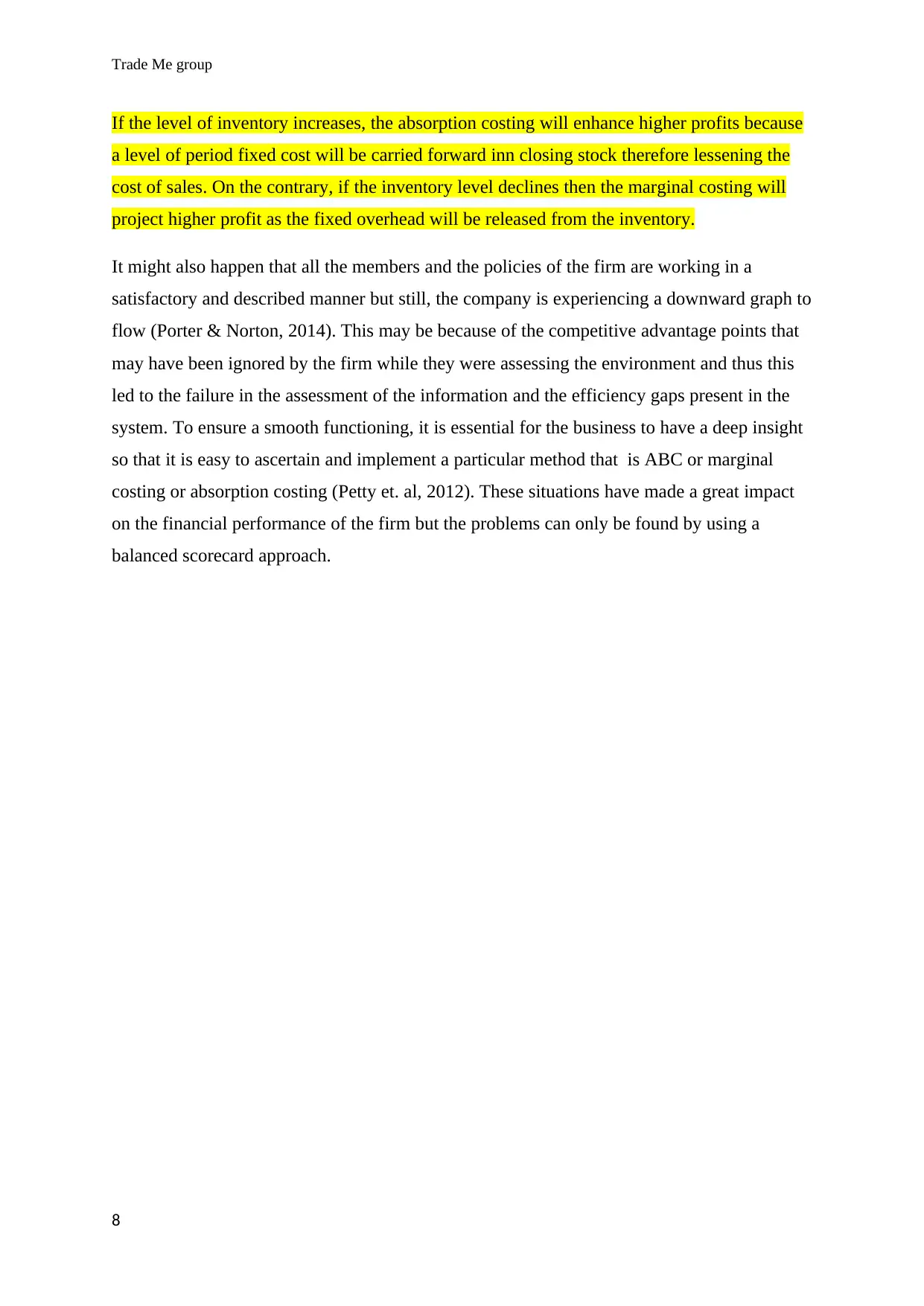
Trade Me group
If the level of inventory increases, the absorption costing will enhance higher profits because
a level of period fixed cost will be carried forward inn closing stock therefore lessening the
cost of sales. On the contrary, if the inventory level declines then the marginal costing will
project higher profit as the fixed overhead will be released from the inventory.
It might also happen that all the members and the policies of the firm are working in a
satisfactory and described manner but still, the company is experiencing a downward graph to
flow (Porter & Norton, 2014). This may be because of the competitive advantage points that
may have been ignored by the firm while they were assessing the environment and thus this
led to the failure in the assessment of the information and the efficiency gaps present in the
system. To ensure a smooth functioning, it is essential for the business to have a deep insight
so that it is easy to ascertain and implement a particular method that is ABC or marginal
costing or absorption costing (Petty et. al, 2012). These situations have made a great impact
on the financial performance of the firm but the problems can only be found by using a
balanced scorecard approach.
8
If the level of inventory increases, the absorption costing will enhance higher profits because
a level of period fixed cost will be carried forward inn closing stock therefore lessening the
cost of sales. On the contrary, if the inventory level declines then the marginal costing will
project higher profit as the fixed overhead will be released from the inventory.
It might also happen that all the members and the policies of the firm are working in a
satisfactory and described manner but still, the company is experiencing a downward graph to
flow (Porter & Norton, 2014). This may be because of the competitive advantage points that
may have been ignored by the firm while they were assessing the environment and thus this
led to the failure in the assessment of the information and the efficiency gaps present in the
system. To ensure a smooth functioning, it is essential for the business to have a deep insight
so that it is easy to ascertain and implement a particular method that is ABC or marginal
costing or absorption costing (Petty et. al, 2012). These situations have made a great impact
on the financial performance of the firm but the problems can only be found by using a
balanced scorecard approach.
8
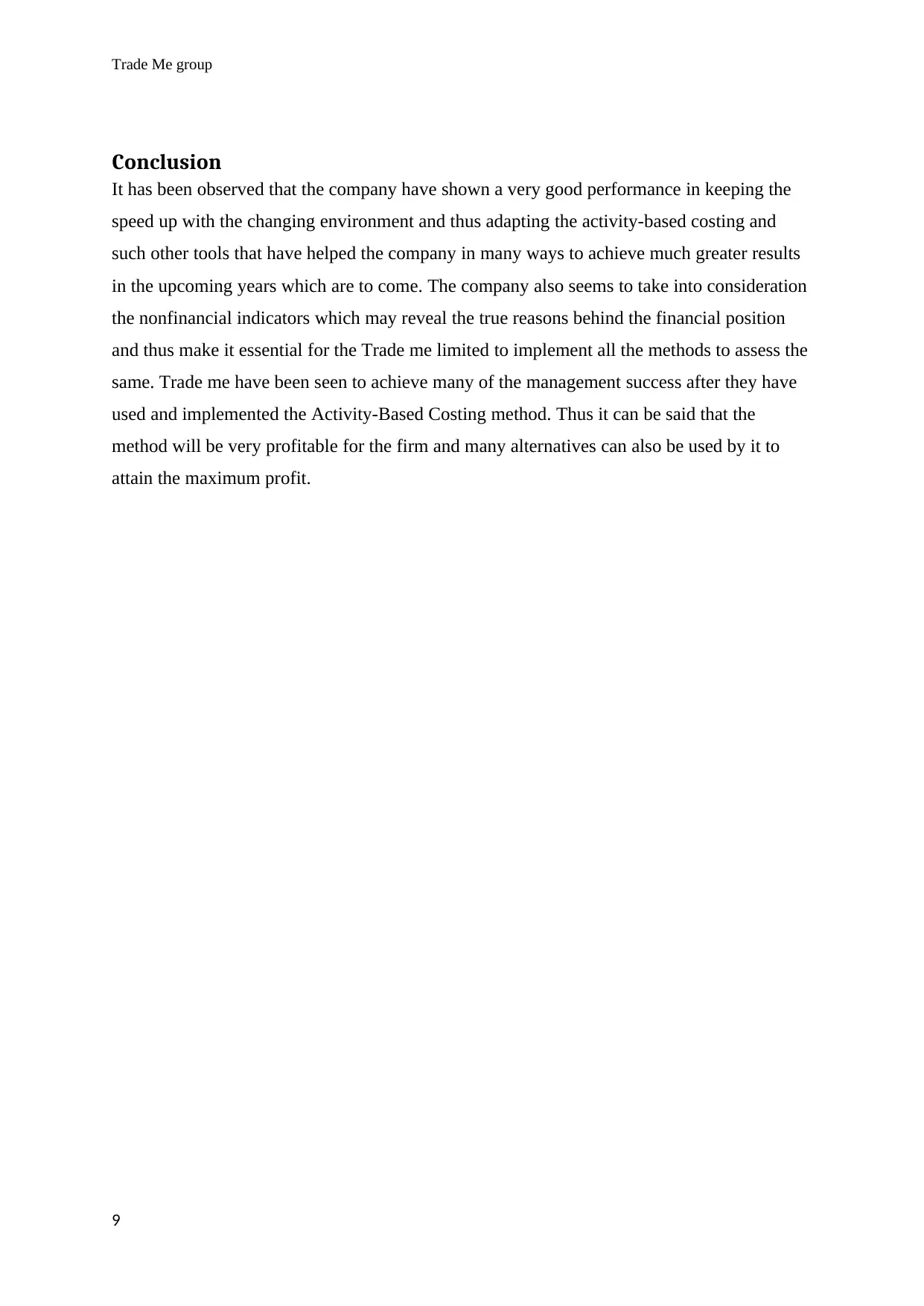
Trade Me group
Conclusion
It has been observed that the company have shown a very good performance in keeping the
speed up with the changing environment and thus adapting the activity-based costing and
such other tools that have helped the company in many ways to achieve much greater results
in the upcoming years which are to come. The company also seems to take into consideration
the nonfinancial indicators which may reveal the true reasons behind the financial position
and thus make it essential for the Trade me limited to implement all the methods to assess the
same. Trade me have been seen to achieve many of the management success after they have
used and implemented the Activity-Based Costing method. Thus it can be said that the
method will be very profitable for the firm and many alternatives can also be used by it to
attain the maximum profit.
9
Conclusion
It has been observed that the company have shown a very good performance in keeping the
speed up with the changing environment and thus adapting the activity-based costing and
such other tools that have helped the company in many ways to achieve much greater results
in the upcoming years which are to come. The company also seems to take into consideration
the nonfinancial indicators which may reveal the true reasons behind the financial position
and thus make it essential for the Trade me limited to implement all the methods to assess the
same. Trade me have been seen to achieve many of the management success after they have
used and implemented the Activity-Based Costing method. Thus it can be said that the
method will be very profitable for the firm and many alternatives can also be used by it to
attain the maximum profit.
9
⊘ This is a preview!⊘
Do you want full access?
Subscribe today to unlock all pages.

Trusted by 1+ million students worldwide
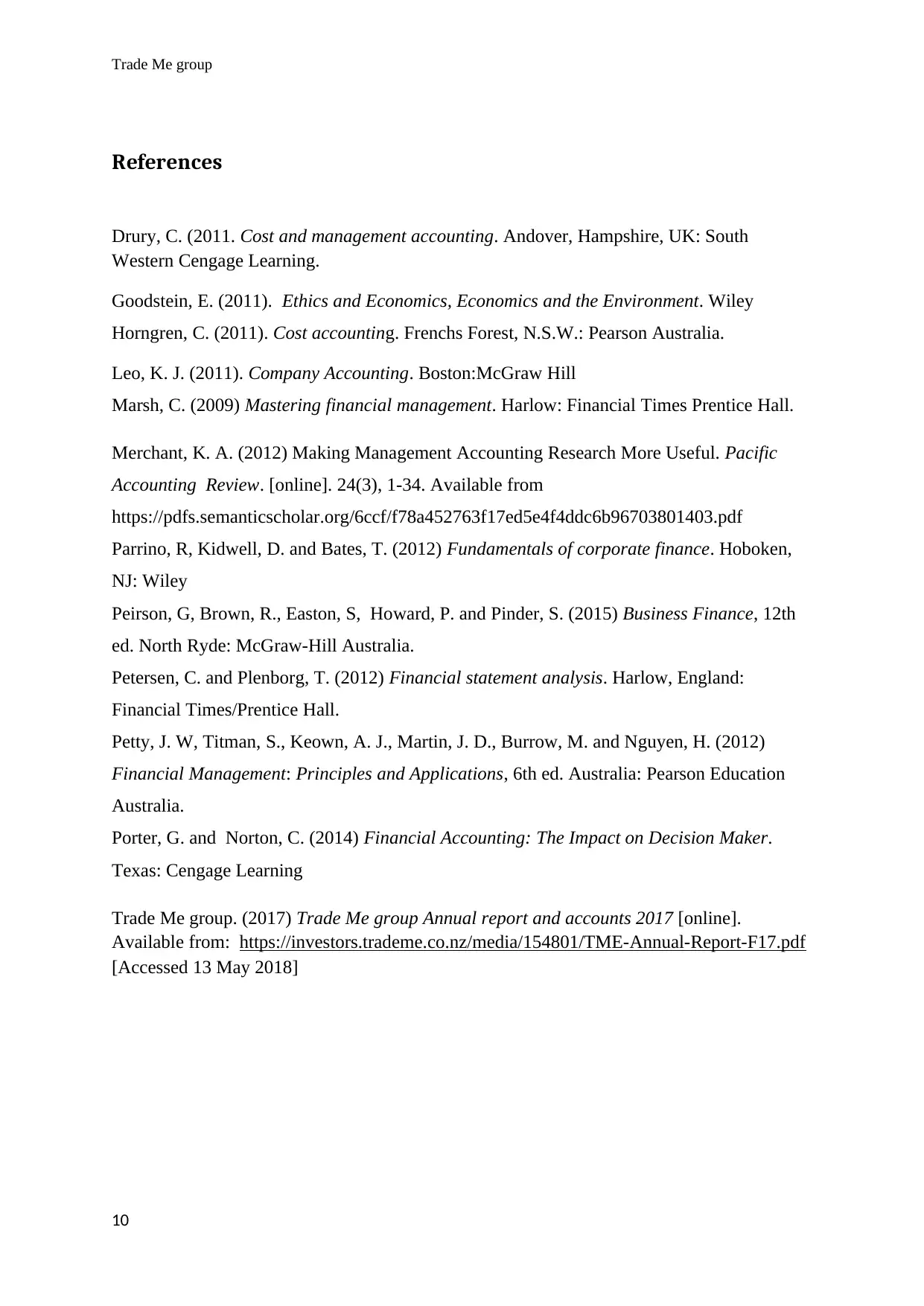
Trade Me group
References
Drury, C. (2011. Cost and management accounting. Andover, Hampshire, UK: South
Western Cengage Learning.
Goodstein, E. (2011). Ethics and Economics, Economics and the Environment. Wiley
Horngren, C. (2011). Cost accounting. Frenchs Forest, N.S.W.: Pearson Australia.
Leo, K. J. (2011). Company Accounting. Boston:McGraw Hill
Marsh, C. (2009) Mastering financial management. Harlow: Financial Times Prentice Hall.
Merchant, K. A. (2012) Making Management Accounting Research More Useful. Pacific
Accounting Review. [online]. 24(3), 1-34. Available from
https://pdfs.semanticscholar.org/6ccf/f78a452763f17ed5e4f4ddc6b96703801403.pdf
Parrino, R, Kidwell, D. and Bates, T. (2012) Fundamentals of corporate finance. Hoboken,
NJ: Wiley
Peirson, G, Brown, R., Easton, S, Howard, P. and Pinder, S. (2015) Business Finance, 12th
ed. North Ryde: McGraw-Hill Australia.
Petersen, C. and Plenborg, T. (2012) Financial statement analysis. Harlow, England:
Financial Times/Prentice Hall.
Petty, J. W, Titman, S., Keown, A. J., Martin, J. D., Burrow, M. and Nguyen, H. (2012)
Financial Management: Principles and Applications, 6th ed. Australia: Pearson Education
Australia.
Porter, G. and Norton, C. (2014) Financial Accounting: The Impact on Decision Maker.
Texas: Cengage Learning
Trade Me group. (2017) Trade Me group Annual report and accounts 2017 [online].
Available from: https://investors.trademe.co.nz/media/154801/TME-Annual-Report-F17.pdf
[Accessed 13 May 2018]
10
References
Drury, C. (2011. Cost and management accounting. Andover, Hampshire, UK: South
Western Cengage Learning.
Goodstein, E. (2011). Ethics and Economics, Economics and the Environment. Wiley
Horngren, C. (2011). Cost accounting. Frenchs Forest, N.S.W.: Pearson Australia.
Leo, K. J. (2011). Company Accounting. Boston:McGraw Hill
Marsh, C. (2009) Mastering financial management. Harlow: Financial Times Prentice Hall.
Merchant, K. A. (2012) Making Management Accounting Research More Useful. Pacific
Accounting Review. [online]. 24(3), 1-34. Available from
https://pdfs.semanticscholar.org/6ccf/f78a452763f17ed5e4f4ddc6b96703801403.pdf
Parrino, R, Kidwell, D. and Bates, T. (2012) Fundamentals of corporate finance. Hoboken,
NJ: Wiley
Peirson, G, Brown, R., Easton, S, Howard, P. and Pinder, S. (2015) Business Finance, 12th
ed. North Ryde: McGraw-Hill Australia.
Petersen, C. and Plenborg, T. (2012) Financial statement analysis. Harlow, England:
Financial Times/Prentice Hall.
Petty, J. W, Titman, S., Keown, A. J., Martin, J. D., Burrow, M. and Nguyen, H. (2012)
Financial Management: Principles and Applications, 6th ed. Australia: Pearson Education
Australia.
Porter, G. and Norton, C. (2014) Financial Accounting: The Impact on Decision Maker.
Texas: Cengage Learning
Trade Me group. (2017) Trade Me group Annual report and accounts 2017 [online].
Available from: https://investors.trademe.co.nz/media/154801/TME-Annual-Report-F17.pdf
[Accessed 13 May 2018]
10
1 out of 10
Related Documents
Your All-in-One AI-Powered Toolkit for Academic Success.
+13062052269
info@desklib.com
Available 24*7 on WhatsApp / Email
![[object Object]](/_next/static/media/star-bottom.7253800d.svg)
Unlock your academic potential
Copyright © 2020–2025 A2Z Services. All Rights Reserved. Developed and managed by ZUCOL.





